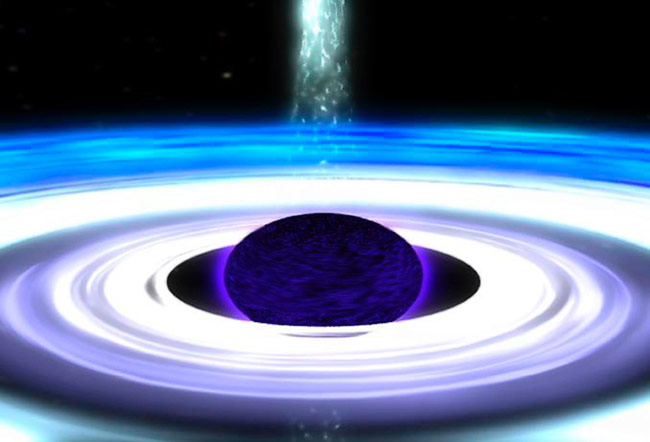Black Holes: Powerhouses of the Universe

The brightest lights in the universe often come from theblackest pits of deep space.
Black holes, so named because even light cannot escape theirgravitational grasp, can only be sensed through their tug on other matter.While black holes themselves are invisible, the regions around them are reignedby powerful magnetic and gravitational forces that create some of the mostluminous radiation ever seen.
Super-bright anomalies like cosmicrays, plasma jets and gamma-ray bursts pour forth to fly across theuniverse, and researchers are just beginning to untangle the mysteries of how theyarise.
Infinitely dense
Black holes are extremelydense masses jammed into single points of space. At their centers, all thematter is crushed to infinite density inside a space of zero volume, called asingularity. There, the pull of gravity is thought to be infinitely strong,warping space-time to be infinitelycurved.
Yet, for all the bizarre happenings inside black holes, ifyou are sufficiently far enough away from them, they act like any other matter.That means that if the sun were replaced with a black hole of the same mass,all the planets would continue to orbit around it just as usual, scientistshave said, though Earth would not be habitable due to lack of sunlight.
Black holes are thought to form during the explosive deathsof very massive stars. When a star exhausts all its fuel, it implodes under thecrushing force of gravity into a denser and denser ball, eventually reducingdown to a black hole. Meanwhile, the outside layers of the star are expelled ina powerful blast called a supernova.
Breaking space news, the latest updates on rocket launches, skywatching events and more!
Rays, bursts and jets
Scientists think some of the energy released by theexplosion and formation of a black hole goes toward accelerating particles togreat speeds, creating marvels called cosmic rays that fly through the universeat almost the speed of light. We detect some of these particles on Earth, wherethey still pack such a punch they can knock out electronics systems.
Another consequence of black holes and supernovas are shortflashes of high-energy gamma-ray light called gamma-raybursts. They originate in distant galaxies and are the brightest thingsever seen in the universe. The bursts likely arise when a very massive,rapidly-rotating star collapses into a black hole during a supernova explosion,and releases a short, intense beam of gamma-ray radiation.
And black holes also seem to be to blame for the jets of hotcharged gas seen spewing from the hearts of distant galaxies. These galaxies, calledblazars, likely have supermassive black holes in their centers that arewarping space-time in extreme ways. As dust and gas gets dragged toward a blackhole, some of it is spit back out and accelerated by twisted magnetic fieldsaround the black hole to shoot out in luminous jets that can be seen across theuniverse.
"We studied a battery mechanism to extract the energy ofa spinning black hole, and it provides a compelling way to power jets in high-energygammaray sources," said Govind Menon, a professor of physics at Alabama'sTroy University.
Menon recently wrote the book "High Energy Radiationfrom Black Holes: Gamma Rays, Cosmic Rays, and Neutrinos," (2009,Princeton University Press) with astrophysicist Charles Dermer of the SpaceScience Division of the Naval Research Laboratory. The two scientists spokeabout the topic Nov. 4 at the 2009 Fermi Symposium in Washington, D.C.
The researchers said even more secrets of black holes arelikely to be discovered soon thanks to new experiments like the Fermi Gamma-raySpace Telescope, the South Pole IceCube Neutrino Experiment, ground-based TeV(1000 GeV) gamma-ray detectors, and the Pierre Auger Cosmic Ray Observatory inArgentina.
"This is a decade of incredible scientific discovery inhigh-energy astronomy and astroparticle physics," Dermer said.
- Video - Black Holes: Warping Time & Space
- Top 10 Star Mysteries
- Vote - The Strangest Things in Space

Clara Moskowitz is a science and space writer who joined the Space.com team in 2008 and served as Assistant Managing Editor from 2011 to 2013. Clara has a bachelor's degree in astronomy and physics from Wesleyan University, and a graduate certificate in science writing from the University of California, Santa Cruz. She covers everything from astronomy to human spaceflight and once aced a NASTAR suborbital spaceflight training program for space missions. Clara is currently Associate Editor of Scientific American. To see her latest project is, follow Clara on Twitter.
